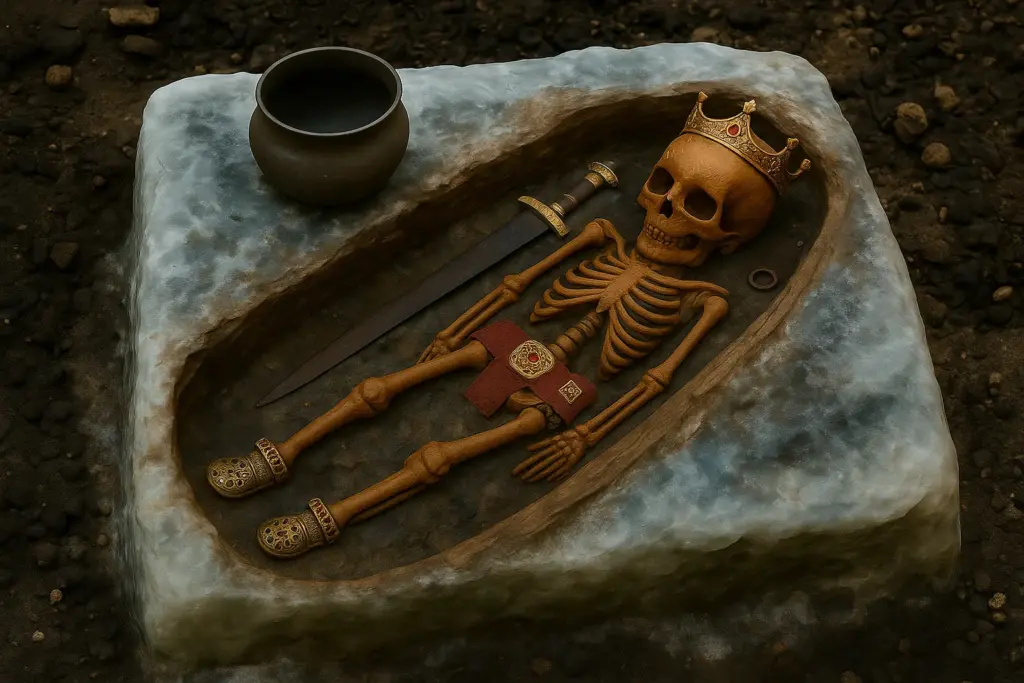
In a groundbreaking discovery, archaeologists in southern Germany have unearthed the lavish burial site of a toddler, dubbed the “Ice Prince of Mattsies,” dating back 1,350 years. The find, made near the town of Mattsies in Bavaria, offers a rare glimpse into the early Middle Ages, revealing the child’s high social status through a meticulous deep freeze analysis of his tomb.
Discovered in 2021 during routine excavations, the burial chamber of the Ice Prince was preserved using an innovative technique. Researchers froze the entire tomb to extract it intact, allowing for a detailed examination of the fragile remains and accompanying artifacts. This method, involving liquid nitrogen, reached temperatures of -196°C, preventing ice crystal formation that could damage the delicate materials.
The Tragic Story of the Ice Prince
The grave belonged to a boy who died between 670 and 680 AD, estimated to be around 18 months old. His death was attributed to a chronic infection, likely stemming from a common middle ear infection. Despite the ordinary cause of death for the period, the elaborate nature of his burial speaks volumes about his family’s status.
Archaeologists from the Bavarian State Office for the Preservation of Monuments (BLfD) were astounded by the grave’s condition and richness. The burial chamber, sealed for over a millennium, was transported to a restoration lab near Bamberg for a comprehensive study. DNA tests revealed the child had blue eyes and light hair, while isotope analysis confirmed his local origin. His dental development indicated he was still being breastfed at his time of death, yet he succumbed to the infection.
Artifacts and Social Status
The burial itself provided significant insights into the child’s life and societal standing. The boy was laid on a fur blanket, dressed in leather shoes, pants, and a fine linen tunic adorned with silk, a luxury material likely acquired through trade with the Byzantine Empire. Silver bracelets, spurs, and a decorated belt with a small sword featuring golden accessories were also found, further indicating his high status.
Among the artifacts was a gold cross wrapped in cloth, and offerings placed at his feet included a bronze basin, a wooden bowl, a silver-fitted cup, fruits like apples and pears, and a dismembered piglet, possibly a cooked dish. These items collectively suggest the Ice Prince belonged to a family of significant regional influence.
The Roman Villa Connection
Perhaps the most telling aspect of the burial is its location. The child was interred in a repurposed Roman villa, a building specially designated as a family tomb. The villa’s roof was reconstructed twice after the child’s burial, indicating its long-term use as a memorial site.
“The boy’s death must have shaken his regionally significant family. They clearly made great efforts to give the child a burial fitting of his social status. In a former Roman villa, a building was specially designated as a burial and memorial space. Skilled stonemasons constructed a stone burial chamber inside it, sealed with lime mortar — a remarkable feat at a time when stone buildings were rare,” stated the General Conservator from BLfD.
Revolutionizing Archaeological Methods
This discovery not only sheds light on the Ice Prince’s story but also highlights a revolutionary approach to archaeology. By freezing and lifting the entire grave, researchers preserved fragile materials like fabric, wood, and food remains that would otherwise have been lost.
“The State Office broke new ground in 2021 with the deep-freezing of the child’s grave. The investigation results now vividly demonstrate how much information can be extracted from such an exceptional burial find through proper recovery methods and detailed analysis,” said Prof. Dipl.-Ing. Mathias Pfeil, General Conservator of the BLfD.
While this method offers a new standard for preserving delicate archaeological finds, it also presents challenges. It requires careful planning, costly equipment, and ideal conditions, meaning not every site can be preserved this way. Nonetheless, it may influence future handling of significant archaeological discoveries.
The discovery of the Ice Prince and the methods used to preserve his grave provide invaluable insights into the past, offering a detailed narrative of life, death, and social structures in the early Middle Ages. As researchers continue to analyze the findings, the story of the Ice Prince will likely yield even more revelations about this fascinating period in history.





